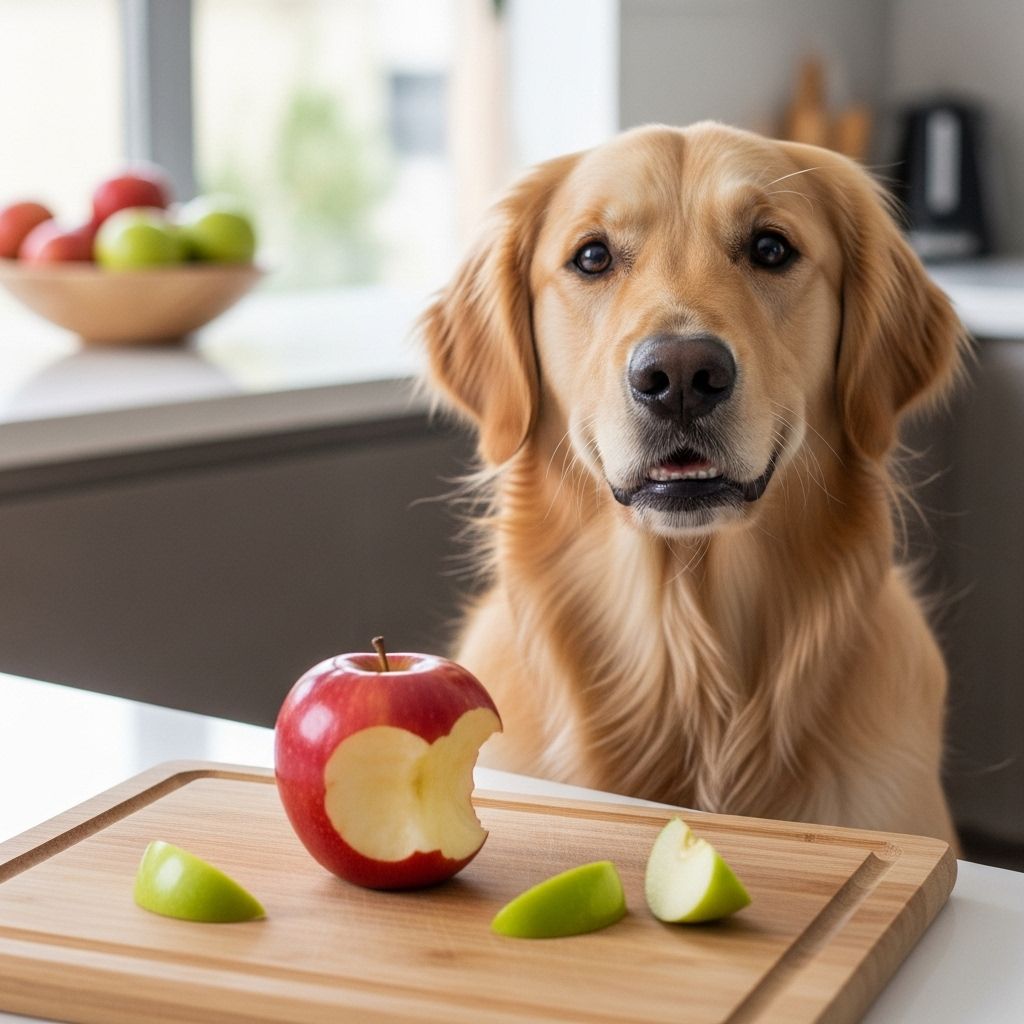Can Dogs Eat Apples? Safety, Nutrition, Risks, and Tips
A fruit snack that delivers vitamins and dental perks when offered with care.

Can Dogs Eat Apples?
Many fruits and vegetables are healthy for humans, but not all are safe for dogs. Apples, however, are generally considered a good snack for most dogs. Rich in vitamins, fiber, and low in calories, apples can offer several health benefits—but feeding them requires some knowledge and care. In this comprehensive guide, we’ll cover everything you need to know about feeding apples to your dog safely, from nutritional benefits and serving tips to potential risks and common questions.
Are Apples Good for Dogs?
Apples can be a healthy addition to your dog’s diet. They are packed with essential nutrients including vitamins A and C, dietary fiber, and a variety of antioxidants. These compounds offer several health advantages:
- Boosting the immune system: Vitamins A and C support immune health, helping your dog fight off illness and infection.
- Supporting digestion: The fiber in apples aids in healthy digestion and regular bowel movements, which can be especially helpful for dogs prone to constipation.
- Promoting dental health: Chewing on apple slices can help clean your dog’s teeth and freshen their breath.
- Low-calorie treat option: Apples are low in fat and protein, making them a great snack for dogs who need to manage their weight.
However, apples should be viewed as a treat, not a main part of your dog’s diet. Always consult your veterinarian before introducing new foods.
Are Apples Safe for Dogs?
Yes, apples are generally safe for dogs to eat in moderation, but there are important precautions every pet owner should follow.
What Parts of Apples Are Safe for Dogs?
Dogs can eat the fleshy part of the apple, but you should always remove the core and seeds. Apple seeds contain cyanogenic glycosides, which can release cyanide when chewed or digested—this can be dangerous, especially in large quantities.
How to Prepare Apples for Dogs
- Remove the core and seeds: Always core the apple and remove all seeds to avoid cyanide poisoning and choking hazards.
- Wash and peel (optional): Washing the apple removes pesticides and debris. Peeling is not necessary for most dogs, but can help avoid choking or digestive issues if your dog is very small or has a sensitive stomach.
- Cut into bite-sized pieces: Slicing apples into small pieces helps prevent choking and allows for easier digestion.
How Many Apples Can a Dog Eat?
Apples should be given in small quantities as occasional treats. Too many apple slices can lead to digestive upset, especially if your dog isn’t used to fiber-rich foods.
Health Benefits of Apples for Dogs
| Nutrient | Benefit for Dogs |
|---|---|
| Vitamin A | Supports vision, immune function, and skin health |
| Vitamin C | Antioxidant; supports immune system and joint health |
| Fiber | Aids digestion and maintains bowel regularity |
| Low Fat & Calories | Healthy snack for weight management |
Regular, modest servings of apple can help promote a shiny coat, healthy skin, and overall vitality. The antioxidants in apples may even help reduce inflammation and the risk of chronic diseases.
Potential Risks and Dangers
While apples are generally beneficial, they do pose some risks if not prepared or served correctly:
- Cyanide in Seeds: Apple seeds contain a compound that can release cyanide when chewed or digested. While the amount in a few seeds is unlikely to harm most dogs, repeated or large doses could be dangerous.
- Choking Hazard: Large apple pieces or the core can cause choking, especially in small dogs.
- Digestive Upset: Too much apple can cause diarrhea or stomach discomfort due to the high fiber content.
- Obesity and Diabetes: Though low in calories, the sugar content means apples should be limited, especially for dogs with diabetes or weight issues.
- Allergies and Sensitivities: Some dogs may have allergies to apples, manifesting as itching, swelling, or gastrointestinal distress. If your dog experiences any adverse reactions, discontinue feeding apples and consult your vet.
- Pesticides and Chemicals: Always wash apples thoroughly to remove pesticides or surface contaminants.
Can Dogs Eat Green Apples?
Yes, green apples are just as safe for dogs as red or yellow varieties, provided they are prepared the same way—seeds and core removed, washed, and cut into small pieces. Green apples are slightly tarter, which some dogs may prefer. They offer the same nutritional benefits and carry the same precautions.
How to Serve Apples to Dogs: Best Practices
- Start Small: Introduce apples gradually to see how your dog reacts.
- Monitor for Reactions: Watch for any signs of allergies or digestive upset.
- Keep Portions Moderate: A few slices a couple of times a week is sufficient.
- Organic or Washed: Opt for organic or thoroughly washed apples to minimize pesticide exposure.
- Mix with Other Treats: Combine apple slices with other dog-friendly fruits or vegetables for variety.
Frequently Asked Questions (FAQs)
Q: Can my dog eat apple skin?
A: In most cases, yes—apple skin is safe and can provide extra fiber. However, wash it well to remove pesticides, and consider peeling if your dog has a sensitive stomach.
Q: What happens if my dog accidentally eats apple seeds?
A: A few seeds are usually not harmful, but large quantities can be dangerous due to the cyanide in them. Monitor your dog for symptoms like vomiting, drooling, or rapid heartbeat, and contact your vet if you notice any concerning signs.
Q: Are there any dogs who should not eat apples?
A: Dogs with diabetes or digestive sensitivities should eat apples only in very limited amounts or after consulting a vet. Dogs with apple allergies should avoid them entirely.
Q: Can apples replace commercial dog treats?
A: Apples should supplement your dog’s regular diet, not replace balanced dog food or treats designed for nutritional completeness. Always feed them in moderation.
Q: How do I know if my dog is allergic to apples?
A: Look for symptoms such as itching, redness, swelling, or gastrointestinal distress after eating apples. If you notice any of these, stop giving apples and consult your vet.
Conclusion
Apples can be a nutritious and enjoyable treat for most dogs when served properly—always core and seed the apple, cut it into bite-sized pieces, and serve in moderation. Watch for any adverse reactions, and never let apples become a primary food source. With the right approach, your dog can enjoy the natural sweetness and health benefits of this popular fruit, safely and happily.
If you’re ever in doubt about what’s safe for your pet, consult your veterinarian for personalized advice. Responsible snacking helps keep your furry friend healthy for years to come!
References
- https://noblevetclinic.com/blog/can-dogs-eat-apples-benefits-and-hazards
- https://www.webmd.com/pets/dogs/can-dogs-eat-apples
- https://brownvethospital.com/blog/can-dogs-eat-apples/
- https://mcgeheeclinic.com/blog/can-dogs-eat-apples/
- https://www.akc.org/expert-advice/nutrition/can-dogs-eat-apples/
- https://us.ziwipets.com/blogs/digestive-health/ultimate-guide-to-feeding-apples-to-dogs-benefits-safety-and-faqs
- https://chippinpet.com/blogs/resource-hub/can-dogs-have-apples
- https://www.goodrx.com/pet-health/dog/can-dogs-eat-apples
- https://www.spotandtango.com/blog/can-dogs-eat-apples
Read full bio of Sneha Tete












